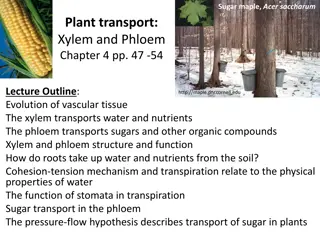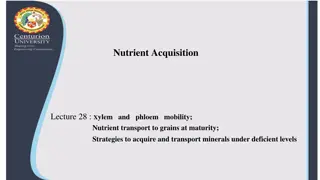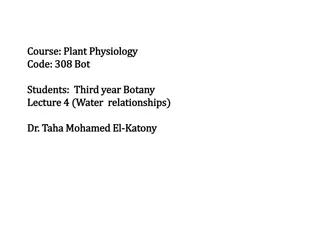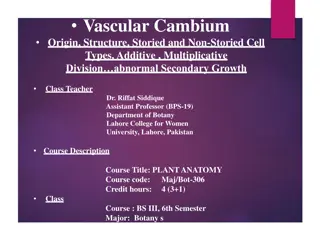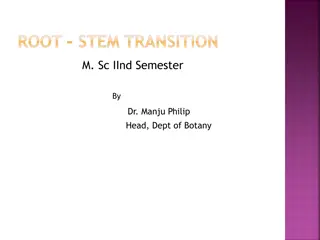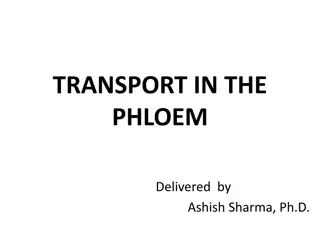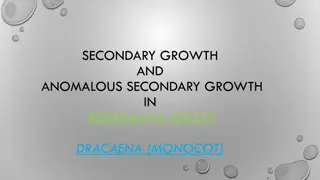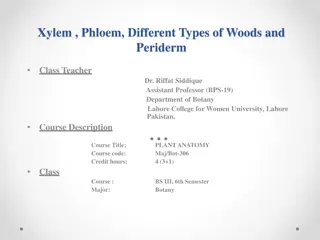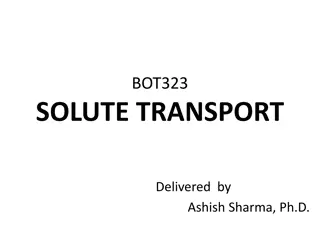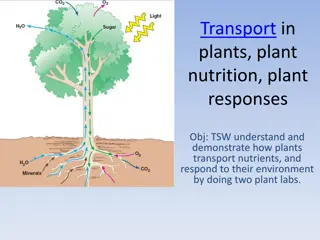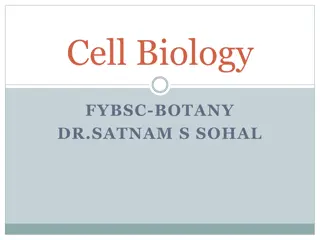Plant Transport Systems: Xylem, Phloem, and Transpiration
This comprehensive lecture outline delves into the intricate mechanisms of water and nutrient transport in plants. Topics covered include the roles of xylem and phloem, root water uptake processes, cohesion-tension mechanism, transpiration, stomatal function, sugar transport in phloem, and the pressure-flow hypothesis. Through detailed illustrations and descriptions, the content explores how plants efficiently move water and nutrients over long distances, highlighting the vital processes of transpiration and the physical properties of water that enable this movement.
Download Presentation

Please find below an Image/Link to download the presentation.
The content on the website is provided AS IS for your information and personal use only. It may not be sold, licensed, or shared on other websites without obtaining consent from the author.If you encounter any issues during the download, it is possible that the publisher has removed the file from their server.
You are allowed to download the files provided on this website for personal or commercial use, subject to the condition that they are used lawfully. All files are the property of their respective owners.
The content on the website is provided AS IS for your information and personal use only. It may not be sold, licensed, or shared on other websites without obtaining consent from the author.
E N D
Presentation Transcript
Sugar maple, Acer saccharum Transport in the Plant Body Chapter 4 pp. 47 -54 Lecture Outline: The xylem transports water and nutrients The phloem transports sugars and other organic compounds Xylem and phloem structure and function How do roots take up water and nutrients from the soil? Cohesion-tension mechanism and transpiration relate to the physical properties of water The function of stomata in transpiration Sugar transport in the phloem The pressure-flow hypothesis describes transport of sugar in plants http://maple.dnr.cornell.edu
H2O H2O and minerals
O2 CO2 Light Sugar H2O O2 H2O and minerals CO2
Long-distance transport in the xylem and the phloem Xylem Phloem Vessel Tracheids 100 m Sieve-tube element (left) and companion cell: cross section Pits Vessel element Sieve-tube elements: longitudinal view Sieve plate with pores Tracheid Tracheids
Transpiration is the evaporative loss of water from the leaves of a plant. H2O H2O and minerals
Transpiration is the movement of water against gravity, from the soil to the leaves, without using any energy HOW do plants do this? http://photo.accuweather.com
Transpiration is the movement of water against gravity, from the soil to the leaves, without using any energy HOW do plants do this? Transpiration depends on: 1. the evaporation of H2O from the leaves, which pulls water upwards from the roots (tension) 2. the physical properties of water (cohesion) http://photo.accuweather.com
Xylem sap Water uptake from the soil Mesophyll cells Stoma Stoma Water molecule Atmosphere Transpiration Adhesion by hydrogen bondingCell Xylem cells wall Water potential gradient Cohesion by hydrogen bonding Cohesion and adhesion in the xylem Water molecule Root hair Soil particle Water uptake from soil 1. Water
Water and mineralsmusttravel from the soil through the dermal and ground tissue into the vascular cylinder (xylem/phloem) of the root eudicot root cross section
epidermis endodermis cortex vascular cylinder eudicot root, cross section
endodermis eudicot root, cross section
The Casparian strip forces water to cross a living membrane in order to reach the xylem endodermis
Casparian strip Transport of water and mineral nutrients from root hairs to the xylem Endodermal cell Pathway along apoplast Pathway through symplast Casparian strip Plasma membrane Apoplastic route Xylem Symplastic route Root hair Epidermis Endodermis Vascular cylinder Cortex
Xylem sap Transpiration: Water evaporates through the stomata Stomata function in transpiration 3. Water molecule Atmosphere Transpiration Adhesion by hydrogen bondingCell Xylem cells wall Water potential gradient Cohesion by hydrogen bonding Cohesion and adhesion in the xylem Water molecule Root hair Soil particle 1. Water uptake from soil Water Water uptake from soil
Xylem sap The ascent of xylem sap (water and minerals) Stomata function in transpiration 3. Water molecule Atmosphere Transpiration Adhesion by hydrogen bondingCell Xylem cells wall Water potential gradient 2. Ascent of the sap Cohesion by hydrogen bonding Cohesion and adhesion in the xylem Water molecule Root hair Soil particle 1. Water uptake from soil Water Water uptake from soil
The ascent of xylem sap depends on hydrogen bonds between water molecules The oxygen (O) is partially The hydrogen (H) is partially + H H2O = water O + H + +
Xylem sap The ascent of xylem sap (water and minerals) Mesophyll cells Stoma Stoma Water molecule Atmosphere Transpiration Adhesion by hydrogen bonding Xylem cells Cell wall Water potential gradient Cohesion by hydrogen bonding Cohesion and adhesion in the xylem Water molecule Root hair Soil particle Water Water uptake from soil
O2 CO2 Light Translocation: Movement of sugars in the phloem Sugar H2O O2 H2O and minerals CO2
O2 CO2 Light Sugar H2O The Pressure-flow hypothesis describes how sugars are transported from sources to sinks via the phloem (this does require energy!) O2 H2O and minerals CO2
Pressure-flow hypothesis Source cell (leaf) Vessel (xylem) Sieve tube (phloem) 1 Load sugar into the phloem at the source (requires ENERGY!) H2O Sugar 1 H2O 2 Water from the xylem flows into the phloem (OSMOSIS) 2 Bulk flow Bulk flow 3 Unload sugar at the sink Sink cell (storage root) Water from the phloem flows back into the xylem (OSMOSIS) water is recycled, creating a constant circuit! 4 3 Sugar H2O Fig. 36-20
Lecture Review, Chap 4, pp. 47-54 Relate structure to function in sieve-tube cells, vessel cells, and tracheid cells. How are water and mineral nutrients from the soil transferred into the vascular cylinder of a root? Define transpiration. Describe the cohesion-tension mechanism and relate it to the function of the stomata and the properties of water. Why do water molecules stick together? How does this relate to why plants can move water against the force of gravity without using any energy? Trace the path of sugar in the phloem from source to sink. What is the name of the hypothesis to describe this flow?


